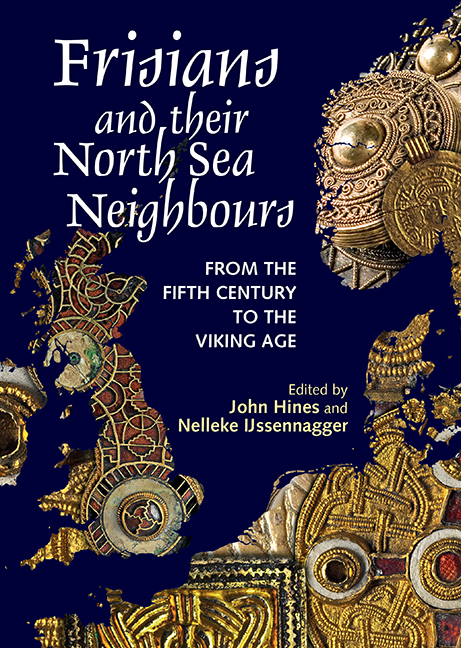Book contents
- Frontmatter
- Contents
- List of Figures
- List of Tables
- Preface
- Acknowledgements
- Linguistic Conventions and Abbreviations
- Abstracts
- Introduction: Frisians – Who, When, Where, Why?
- 1 Palaeogeography and People: Historical Frisians in an archaeological light
- 2 The Anglo-Frisian Question
- 3 Frisian between the Roman and the Early Medieval Periods: Language contact, Celts and Romans
- 4 ‘All quiet on the Western Front?’ The Western Netherlands and the ‘North Sea Culture’ in the Migration Period
- 5 Power and Identity in the Southern North Sea Area: The Migration and Merovingian Periods
- 6 How ‘English’ is the Early Frisian Runic Corpus? The evidence of sounds and forms
- 7 The Geography and Dialects of Old Saxon: River-basin communication networks and the distributional patterns of North Sea Germanic features in Old Saxon
- 8 Between Sievern and Gudendorf: Enclosed sites in the north-western Elbe–Weser triangle and their significance in respect of society, communication and migration during the Roman Iron Age and Migration Period
- 9 Cultural Convergence in a Maritime Context: Language and material culture as parallel phenomena in the early-medieval southern North Sea region
- 10 The Kingdom of East Anglia, Frisia and Continental Connections, c. ad 600–900
- 11 A Comparison of the Injury Tariffs in the Early Kentish and the Frisian Law Codes
- 12 Cultural Contacts between the Western Baltic, the North Sea Region and Scandinavia: Attributing runic finds to runic traditions and corpora of the Early Viking Age
- Index
4 - ‘All quiet on the Western Front?’ The Western Netherlands and the ‘North Sea Culture’ in the Migration Period
Published online by Cambridge University Press: 25 August 2018
- Frontmatter
- Contents
- List of Figures
- List of Tables
- Preface
- Acknowledgements
- Linguistic Conventions and Abbreviations
- Abstracts
- Introduction: Frisians – Who, When, Where, Why?
- 1 Palaeogeography and People: Historical Frisians in an archaeological light
- 2 The Anglo-Frisian Question
- 3 Frisian between the Roman and the Early Medieval Periods: Language contact, Celts and Romans
- 4 ‘All quiet on the Western Front?’ The Western Netherlands and the ‘North Sea Culture’ in the Migration Period
- 5 Power and Identity in the Southern North Sea Area: The Migration and Merovingian Periods
- 6 How ‘English’ is the Early Frisian Runic Corpus? The evidence of sounds and forms
- 7 The Geography and Dialects of Old Saxon: River-basin communication networks and the distributional patterns of North Sea Germanic features in Old Saxon
- 8 Between Sievern and Gudendorf: Enclosed sites in the north-western Elbe–Weser triangle and their significance in respect of society, communication and migration during the Roman Iron Age and Migration Period
- 9 Cultural Convergence in a Maritime Context: Language and material culture as parallel phenomena in the early-medieval southern North Sea region
- 10 The Kingdom of East Anglia, Frisia and Continental Connections, c. ad 600–900
- 11 A Comparison of the Injury Tariffs in the Early Kentish and the Frisian Law Codes
- 12 Cultural Contacts between the Western Baltic, the North Sea Region and Scandinavia: Attributing runic finds to runic traditions and corpora of the Early Viking Age
- Index
Summary
For a long time, the only claim the western Netherlands had to participation in the 5th-century adventus Saxonum was based upon a handful of Anglo-Saxon pots in three cemeteries in the Rhine estuary. Recent research, however, dates these pots to the 6th century, thus beyond the initial period of migrations from Old Saxony (Niedersachsen) to Britain. Together with other differences in material culture, this clearly reveals a contrast to developments in the terpen area of Friesland and Groningen. The internal partition in the Lex Frisionum into three parts also points to regional differences (see further Knol and IJssenagger, and Nijdam, this vol.). Even within the region of West Frisia, the modern provinces of North and South Holland, regular archaeological distinctions can be found. Bazelmans (2009, 332–3) has already pointed to the fragmented ethnicity the different coastal regions must have had, following the crisis in habitation they all went through between the late 3rd and early 6th century ad.
At the same time there were some shared characteristics in the Frisian coastal region, such as brooches of the Domburg Type (Deckers, this vol.). How does this all add up to a coherent picture of the habitation history of the Dutch west coast in the Migration Period? In this paper a general outline is presented of the recent research of both authors as part of the former ‘Frisia Project’, taking an interdisciplinary approach (Dijkstra and van der Velde 2011; Dijkstra 2011; de Koning 2003; 2012).
An introductory warning about geographical terminology is required, however. In German studies present-day Friesland is called ‘West Frisia’, to distinguish it from the German East and North Frisia (e.g. Bos 2001, 490 and map 1). This is confusing, because in the Early Middle Ages the littoral of the western Netherlands was known as Frisia as well, and its inhabitants as Fresiones or Fresiones occidentales (West Frisians). The name Holland did not come into regular use until c. 1100, reserving the name West-Friesland for the northernmost part of Holland until the present day (Blok 1969). Consequently we prefer to refer to modern Friesland as Middle Frisia (Fig. 4.1).
- Type
- Chapter
- Information
- Frisians and their North Sea NeighboursFrom the Fifth Century to the Viking Age, pp. 53 - 74Publisher: Boydell & BrewerPrint publication year: 2017
- 1
- Cited by

